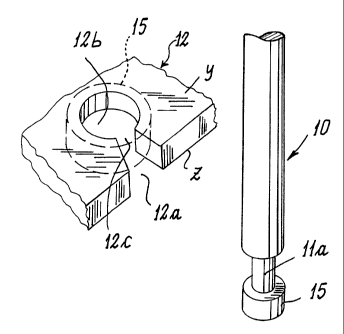Some of the information on this Web page has been provided by external sources. The Government of Canada is not responsible for the accuracy, reliability or currency of the information supplied by external sources. Users wishing to rely upon this information should consult directly with the source of the information. Content provided by external sources is not subject to official languages, privacy and accessibility requirements.
Any discrepancies in the text and image of the Claims and Abstract are due to differing posting times. Text of the Claims and Abstract are posted:
| (12) Patent: | (11) CA 2354872 |
|---|---|
| (54) English Title: | WALL ELEMENT INCORPORATING IDLE ROLLERS |
| (54) French Title: | ELEMENT MURAL COMPRENANT DES ROULEAUX LIBRES |
| Status: | Deemed expired |
| (51) International Patent Classification (IPC): |
|
|---|---|
| (72) Inventors : |
|
| (73) Owners : |
|
| (71) Applicants : |
|
| (74) Agent: | ROBIC |
| (74) Associate agent: | |
| (45) Issued: | 2010-04-06 |
| (22) Filed Date: | 2001-08-08 |
| (41) Open to Public Inspection: | 2002-02-09 |
| Examination requested: | 2006-07-10 |
| Availability of licence: | N/A |
| (25) Language of filing: | English |
| Patent Cooperation Treaty (PCT): | No |
|---|
| (30) Application Priority Data: | ||||||
|---|---|---|---|---|---|---|
|
A wall element incorporating idle rollers, presenting a body with seats into which stationary pins carrying idle rollers are snap- fitted; said body presents two parts (22, 30), of which one is the lower base part (22) and the other the upper base part (30), these being structurally separate, but connected together by just the pins (10, 21), which present end portions (15, 15A) transversely wider than adjacent portions (11a, 21a) provided for their snap-fitting into seats (12a,b,c; 22a,b,c) in said two parts (22, 30), said wider portions (15, 15A) abutting against said seats to prevent any movement of said parts (22, 30) in the axial direction of the pins (10, 21).
Un élément mural comprenant des rouleaux libres et présentant un corps avec des sièges sur lesquels sont encliquetées des broches stationnaires qui retiennent les rouleaux libres; le corps présente deux parties (22, 30) : la partie de base inférieure (22) et la partie de base supérieure (30). Ces deux parties sont structurellement séparées, mais uniquement reliées par les broches (10, 21), et leurs extrémités (15, 15A) sont plus larges de façon transversale que les parties adjacentes (11a, 21a) pour permettre leur attache rapide dans les sièges (12a,b,c; 22a,b,c) des deux parties (22, 30). Les parties plus larges (15, 15A) butent contre les sièges pour empêcher tout mouvement des parties (22, 30) dans la direction axiale des broches (10, 21).
Note: Claims are shown in the official language in which they were submitted.
Note: Descriptions are shown in the official language in which they were submitted.

For a clearer understanding of the status of the application/patent presented on this page, the site Disclaimer , as well as the definitions for Patent , Administrative Status , Maintenance Fee and Payment History should be consulted.
| Title | Date |
|---|---|
| Forecasted Issue Date | 2010-04-06 |
| (22) Filed | 2001-08-08 |
| (41) Open to Public Inspection | 2002-02-09 |
| Examination Requested | 2006-07-10 |
| (45) Issued | 2010-04-06 |
| Deemed Expired | 2014-08-08 |
There is no abandonment history.
| Fee Type | Anniversary Year | Due Date | Amount Paid | Paid Date |
|---|---|---|---|---|
| Registration of a document - section 124 | $100.00 | 2001-08-08 | ||
| Application Fee | $300.00 | 2001-08-08 | ||
| Maintenance Fee - Application - New Act | 2 | 2003-08-08 | $100.00 | 2003-08-01 |
| Maintenance Fee - Application - New Act | 3 | 2004-08-09 | $100.00 | 2004-08-04 |
| Maintenance Fee - Application - New Act | 4 | 2005-08-08 | $100.00 | 2005-07-26 |
| Request for Examination | $800.00 | 2006-07-10 | ||
| Maintenance Fee - Application - New Act | 5 | 2006-08-08 | $200.00 | 2006-07-26 |
| Maintenance Fee - Application - New Act | 6 | 2007-08-08 | $200.00 | 2007-06-29 |
| Maintenance Fee - Application - New Act | 7 | 2008-08-08 | $200.00 | 2008-07-07 |
| Maintenance Fee - Application - New Act | 8 | 2009-08-10 | $200.00 | 2009-06-19 |
| Registration of a document - section 124 | $100.00 | 2009-12-04 | ||
| Final Fee | $300.00 | 2010-01-15 | ||
| Maintenance Fee - Patent - New Act | 9 | 2010-08-09 | $200.00 | 2010-07-16 |
| Maintenance Fee - Patent - New Act | 10 | 2011-08-08 | $250.00 | 2011-07-27 |
| Maintenance Fee - Patent - New Act | 11 | 2012-08-08 | $250.00 | 2012-07-17 |
Note: Records showing the ownership history in alphabetical order.
| Current Owners on Record |
|---|
| SYSTEM PLAST S.R.L. |
| Past Owners on Record |
|---|
| MARSETTI, SERGIO |
| REATTI, RODOLFO |
| SYSTEM PLAST S.P.A. |